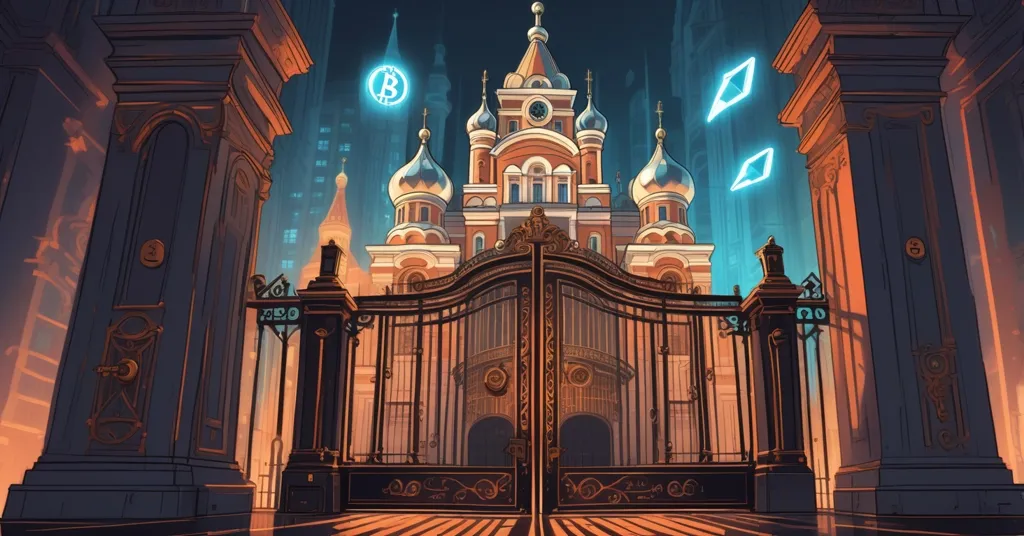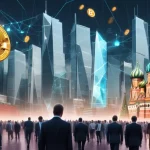Moscow Exchange Launches Ethereum Futures: A Step Forward or Elite-Only Access?

Moscow Exchange Dives into Ethereum Futures: Progress or a Gated Elite Playground?
Russia’s financial heavyweight, the Moscow Exchange (MOEX), is stirring the pot with its latest announcement: a futures contract tied to BlackRock’s iShares Ethereum Trust ETF (ETHA) set to launch in August 2024. Fresh off their Bitcoin futures rollout in June, this move hints at a reluctant embrace of cryptocurrency derivatives in a nation notorious for its crypto skepticism. But is this a genuine step toward blockchain adoption, or just another exclusive club for the financial elite?
- Ethereum Futures Launch: MOEX to introduce futures tracking BlackRock’s ETHA ETF in August 2024, cash-settled in rubles for qualified investors only.
- Bitcoin Foundation: Builds on Bitcoin futures tied to BlackRock’s IBIT ETF, launched June 4, 2024, with similar restrictions.
- Diversified Strategy: Alongside crypto, MOEX plans futures for US Treasury bonds and Chinese tech stocks like Tencent and Xiaomi.
MOEX’s Crypto Venture: Breaking Down the Ethereum Futures
Let’s get into the nuts and bolts of this development. The Moscow Exchange is rolling out a futures contract linked to the iShares Ethereum Trust ETF (ETHA), a NASDAQ-listed fund managed by BlackRock, which debuted in July 2024. For those new to the game, a futures contract is a deal to buy or sell an asset at a set price on a future date. In this case, it’s “cash-settled” in rubles, meaning you don’t get Ethereum or ETF shares at the end—just the equivalent value in Russian currency. The contract size, or the total value each contract represents, will be smaller than that of MOEX’s Bitcoin futures, potentially lowering the entry risk for investors. For more on this launch, check out the Ethereum futures announcement by MOEX.
“The fund’s underlying asset will be the BlackRock-run iShares Ethereum Trust ETF. Its quotation will be equal to the cost of one share of the fund. The contract size will be slightly smaller than [that we use for the] IBIT [the iShares Bitcoin Trust ETF].” – Maria Patrikeyeva, Managing Director of Moscow Exchange Derivatives Market
Now, what’s an ETF? Think of it as a mini-portfolio you can buy shares in—a basket of assets tracking Ethereum’s price without owning the actual coins. Access to these futures, however, is locked behind a “qualified investors only” label, typically meaning high-net-worth individuals or institutions who meet strict financial criteria under Russian law. So, if you’re a regular Ivan curious about crypto, you’re stuck on the sidelines watching the big players trade. This exclusivity reeks of the same old gatekeeping, just with a shiny blockchain wrapper. To understand more about how these contracts work, take a look at this explanation of Ethereum futures.
This isn’t MOEX’s first rodeo with crypto derivatives. On June 4, 2024, they launched Bitcoin futures tied to BlackRock’s iShares Bitcoin Trust ETF (IBIT), following a similar restricted, ruble-settled model. The Ethereum futures are a natural next step, but the smaller contract size suggests a cautious approach—perhaps a nod to Ethereum’s wild price swings or simply a way to test demand without overcommitting.
Russia’s Crypto Dance: From Hostility to Pragmatism
To grasp why MOEX is dipping its toes into crypto now, we need to zoom out to Russia’s broader financial chessboard. Historically, the Central Bank of Russia has treated cryptocurrencies like a financial plague, warning of risks to stability and links to illicit activity. But since 2022, with sanctions over the Ukraine conflict cutting access to global banking systems like SWIFT, there’s been a quiet pivot. Crypto has emerged as a potential workaround for international transactions, even if the government keeps it on a tight leash. For deeper insight into this shift, explore this analysis of Russia’s crypto regulation stance.
MOEX’s strategy isn’t just about crypto—it’s about survival through diversification. Alongside Ethereum and Bitcoin futures, they’re launching contracts tied to the iShares 20+ Year Treasury Bond ETF for US debt securities (a play for steady returns) and shares of Chinese tech giants Tencent and Xiaomi on the Hong Kong Stock Exchange (a bet on growth markets). This mix screams pragmatism: balance the high-octane volatility of crypto with safer, yield-driven assets and emerging market exposure. It’s less about loving blockchain and more about navigating a sanctioned economy.
Other Russian financial players, like Sber (the nation’s largest bank) and Finam, are also sniffing around crypto-linked products. If this turns into a domestic race, we might see a rare regulatory thaw—or just more elite-only toys. MOEX itself is awaiting approval for mutual funds and structured bonds tied to crypto indices, which could further legitimize digital assets in Russia. But given the Central Bank’s track record, don’t hold your breath for retail access anytime soon. This bear is learning to dance with crypto, but it’s a clumsy, cautious shuffle. For additional context on growing interest, see this report on Russia’s crypto adoption.
Bitcoin vs. Ethereum: Why MOEX Bets on Both
From a Bitcoin maximalist perch, I’ll always argue that BTC is the bedrock of this revolution—digital gold, a store of value, a middle finger to centralized control. But Ethereum brings a different beast to the table, and MOEX’s interest in both deserves a closer look. Unlike Bitcoin, which focuses on being a scarce, decentralized currency, Ethereum acts like a global computer. Its smart contracts—self-executing agreements coded on the blockchain—power everything from decentralized finance (DeFi) protocols, where you can lend or borrow without a bank, to non-fungible tokens (NFTs) that tokenize unique digital assets like art or collectibles. To learn more about MOEX’s role in this space, visit the Moscow Exchange overview.
Ethereum’s ecosystem is a playground for innovation, hosting thousands of decentralized applications (dApps) that aim to disrupt traditional middlemen. If Bitcoin is about holding value outside the system, Ethereum is about rebuilding the system itself. MOEX’s nod to Ethereum futures might hint at an appetite for these broader blockchain use cases, even if it’s just indirect exposure through a sanitized ETF. For us decentralization purists, it’s a half-hearted gesture—still cool to see Ethereum’s potential getting airtime in a place like Russia.
Risks on the Horizon: Not All Glitter Is Gold
Before we get too excited about Russia’s crypto pivot, let’s slap on some reality goggles. These futures don’t give you direct exposure to Bitcoin or Ethereum—you’re betting on the price of a US-listed ETF managed by BlackRock. That means you’re at the mercy of foreign market swings, regulatory whims in the US, and geopolitical spats that could mess with the ETF’s operations. Imagine a US policy tweak clamping down on crypto ETFs; MOEX investors would feel the shockwave without a say in the matter. For details on the ETF’s performance and risks, check out BlackRock’s iShares Ethereum Trust ETF page.
Then there’s the ruble settlement. With Russia’s currency bouncing around like a pinball due to sanctions, you’re layering extra risk on an already volatile asset class. Ethereum itself has seen price swings of 20-30% in a single month historically, and with no performance history yet for ETHA (as per BlackRock’s own admission), you’re essentially gambling on an untested vehicle. MOEX’s smaller contract size for Ethereum compared to Bitcoin might be a hedge against this chaos, but it’s a flimsy shield against the Wild West of crypto markets—think hacks, flash crashes, and sudden regulatory U-turns.
Geopolitical tension adds another thorn. Russia’s post-sanction financial isolation drives this diversification, but relying on US-based assets like ETHA and IBIT for futures feels like building on shaky ground. If East-West relations sour further, could access to these underlying ETFs get tangled in red tape? It’s not far-fetched, and investors betting on MOEX’s crypto derivatives need to weigh this wildcard. For more specifics on this initiative, refer to this detailed report on MOEX’s Ethereum fund launch.
Decentralization Betrayed? TradFi’s Iron Grip
Let’s cut through the hype with a sharp blade. This ain’t decentralization—it’s a polished repackaging of crypto for the same old gatekeepers, masquerading as progress. MOEX’s futures, locked behind a “qualified investors only” wall, are a blatant lockout for regular folks. The average Russian dabbling in crypto gets nothing but crumbs while the fat cats play with blockchain toys. It’s the opposite of Bitcoin’s peer-to-peer vision, where anyone, anywhere, can participate without permission.
From an effective accelerationism (e/acc) angle, there’s a silver lining: even this gated entry speeds crypto’s creep into legacy finance, flaws be damned. Pushing blockchain tech into traditional systems, however imperfectly, aligns with the drive to fast-track disruptive innovation. But as champions of freedom and privacy, we’ve got to call bullshit on anything that dilutes the ethos of cutting out middlemen. This is TradFi co-opting crypto’s allure while keeping the reins tight—mainstreaming, yes, but at the cost of the raw, rebellious spirit that birthed this movement. For community perspectives, browse this discussion on crypto futures in Russia.
Global Lens: Where Does Russia Stand?
Russia isn’t alone in blending TradFi with crypto. The US greenlit spot Bitcoin and Ethereum ETFs in 2024, sparking a wave of institutional products. Hong Kong has rolled out crypto futures, positioning itself as an Asian hub for digital assets. Even the EU is tiptoeing into regulated blockchain instruments. MOEX’s move, while restricted, mirrors this global inevitability—traditional finance can’t ignore crypto’s momentum, even if they insist on slapping it with heavy controls.
Yet, Russia’s context is unique. Sanctions and isolation add a layer of desperation to their diversification, unlike the US or Hong Kong, where it’s more about market opportunity. MOEX’s reliance on foreign ETFs also sets it apart, introducing risks others might dodge with domestic assets. This places Russia in an odd spot: a latecomer to the crypto party, playing catch-up with one hand tied behind its back by regulation and geopolitics.
Key Takeaways and Questions
- What are MOEX’s new Ethereum futures?
A futures contract launching in August 2024, tied to BlackRock’s iShares Ethereum Trust ETF (ETHA), cash-settled in rubles and restricted to qualified investors. - How do they relate to MOEX’s Bitcoin futures?
They follow the Bitcoin futures tied to BlackRock’s IBIT ETF from June 2024, with a similar model but a smaller contract size, showing a cautious crypto expansion. - Why is Russia’s MOEX entering crypto derivatives now?
Likely driven by sanctions since 2022 limiting global banking access, pushing interest in crypto as an alternative, alongside a worldwide trend of TradFi adopting blockchain instruments. - What risks come with tying futures to US-based ETFs?
Exposure to foreign regulatory shifts, market volatility, and geopolitical tensions, plus ruble settlement risks amid currency fluctuations due to sanctions. - How does Ethereum differ from Bitcoin in this context?
Bitcoin serves as digital gold for value storage, while Ethereum’s smart contracts enable DeFi and NFTs, hinting at MOEX’s interest in broader blockchain potential. - Does this advance crypto’s decentralization ethos?
Hardly—it’s a centralized, TradFi-controlled product limiting access, straying from Bitcoin’s peer-to-peer freedom despite accelerating mainstream exposure. - Should we be hopeful about crypto adoption in Russia?
Cautiously; institutional steps are positive, but strict regulations and elite-only access mean true, widespread adoption remains a distant goal for most Russians. - How does Russia’s move compare globally?
It aligns with US and Hong Kong TradFi-crypto integrations, but sanctions and reliance on foreign ETFs add unique risks, positioning Russia as a constrained player in this space.
MOEX’s Ethereum futures launch is a curious chapter in the global crypto saga. It showcases the relentless pull of Bitcoin, Ethereum, and blockchain tech, worming their way into even the most skeptical corners of finance. Yet, it’s a stark reminder that the path to decentralization often detours through centralized power plays. For every stride toward mainstream acceptance, there’s a tug back toward control. We’re keeping our eyes peeled, cutting through the noise with no fluff—just the gritty reality of this financial uprising. Stick with us as we track whether Russia’s crypto flirtation blooms into something real or stays a walled garden for the privileged few.



